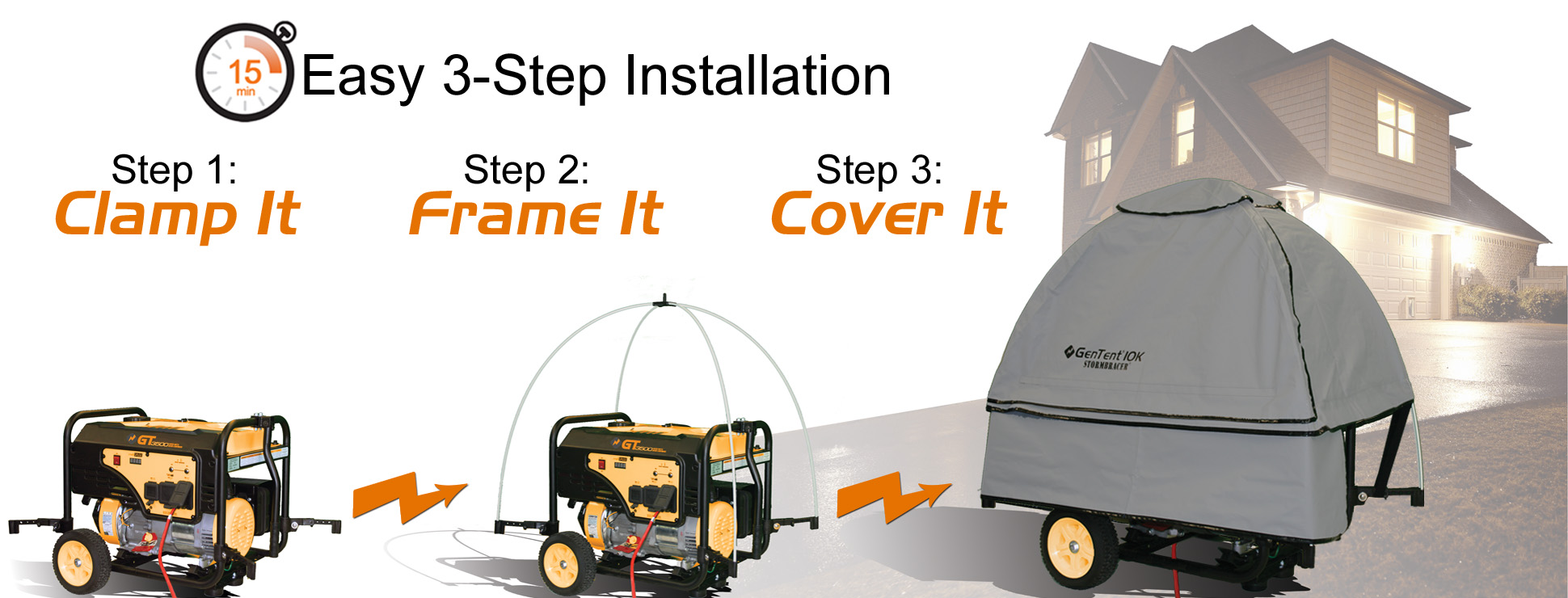
We all know how important backup power can be with the unpredictability of today’s weather systems. Most often, if people are not hiring an electrician to install an always ready standby generator, they are in the market for a portable generator which can give them some of the comforts and home necessities they are accustom to.
When shopping for a portable generator, it is important to understand how to run them safely and effectively. Running a generator indoors or un-vented can kill you in as little as 5 minutes from concentration of carbon monoxide. When choosing the right generator for your home, consider purchasing a cover to protect your investment. There are many options to look at and pricing varies from hundreds of dollars down to $19.00. The following article will compare two portable generator covers that are fairly inexpensive. It is the GenTent Safety Canopy vs. the IGAN Portable Running Cover.

Th GenTent Stormbracer is American made and the price point is between $149.99 and $164.99. It has been tested and verified by independent lab testing and has also been storm proven in every major system since 2012’s Super Storm Sandy. 
One of the most important features of any generator cover is keeping the generator cool. This cover does exactly that. It does not obstruct the handles, wheels, vents, intake or exhaust; and if any one of those items are obstructed, a custom kit will be created for the generator. This includes inverter models, which are the largest growing segment in portable generators. This cover will fit 2,000 generators and the company has a proprietary matching system on their website which explains which product best outfits a generator or if they are disqualified.

A few more important facts: the standard cover has a one-year warranty on the canopy and three years on the parts, which are all NFPA 701 rated. The NFPA is the National Fire Protection Association which means this cover and associated pieces will not auto ignite. The cover is engineered and designed to allow air flow through the dome shape and be released through the top cap. In addition, the cover has been tested with the CO sensor generators, which are designed to shut off with the presence of a certain level of CO buildup.
The IGAN Portable Generator Cover is made in China. Pricing for this cover is $129.99. There has been no testing or claims to third party testing and no confirmed claims or evidence or product performance in bad weather. Because there has been no testing of this product, the information gathered for this article will rely on customer reviews and the specs for the cover listed online.
This cover is assembled in approximately 15 to 20 minutes, with quite a few customers making note of the hard to assemble frame.

The cover cannot be used with many common handle sets, including Ridgid, or Generac XG and CO Sense Series. Another customer review showed a video of the product flying off the generator in 25 MPH winds. 
In regard to keeping the generator cool during a storm, one customer wrote that the cover melted and burned with 200 degrees of heat, which means that the National Fire Protection Association has not reviewed the product. Typical exhaust gas temperatures immediately leaving the exhaust pipe range from 600-900 degrees Fahrenheit. The running cover has by design no relief for wayward hot air or top oriented exhaust, this will eventually cause damage not only to the cover itself, but the generator. The cover is made from heavy duty waterproof tarp, touting a significant weight at 9 lbs.
 It is important to learn as much as you can when purchasing something as valuable to your home’s safety as a generator because the weather can be unpredictable: heavy snow, hurricane force winds and heavy rains. Losing power can be uncertainty or it can become a thing of the past when you purchase a generator cover which has been vetted by independent testing and is storm proven, your family’s safety depends on it.
It is important to learn as much as you can when purchasing something as valuable to your home’s safety as a generator because the weather can be unpredictable: heavy snow, hurricane force winds and heavy rains. Losing power can be uncertainty or it can become a thing of the past when you purchase a generator cover which has been vetted by independent testing and is storm proven, your family’s safety depends on it.
In conclusion, when comparing Gentent and IGAN, the differences are clear. Gentent has been vetted by independent testing, including the National Fire Protection Association. IGAN has not. Gentent has a flame resistant canopy. IGAN does not. Gentent can withstand 70 MPH winds. IGAN fails at 25 MPH. Gentent can carry a 55 lbs snow load. IGAN fails at 5 lbs. These are powerful differences: wind, snow and fire. Gentent will come through for you when you need it most.
 GenTent proves to be a winner both in our review of these products as well as through customer testimonial.
GenTent proves to be a winner both in our review of these products as well as through customer testimonial.


